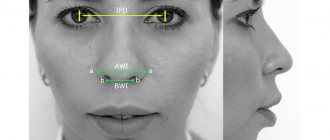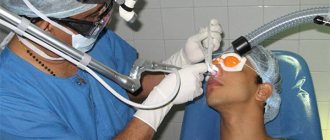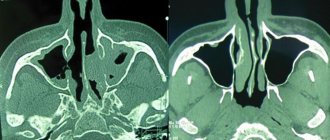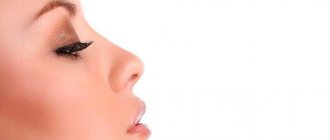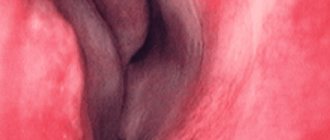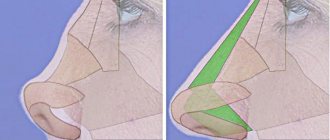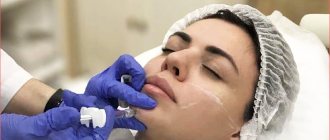You've probably noticed that many people have dimples on their faces, which are another significant difference that allows us to judge individual character traits. There is an opinion that dimples on the face decorate a person and make his face more interesting. Yes, indeed, a face with dimples attracts attention, and the dimples themselves have long become a topic of conversation and have taken their place in the science of personality cognition with the help of physiognomy. So what do dimples mean?
Dimples
So, the most attractive dimples that give a person a special charm and make his face more friendly and pretty are the dimples on the cheeks. Such signs indicate sensuality, increased emotionality and a “mad” temperament, although outwardly this may not manifest itself too strongly. Along with this, dimples on the cheeks indicate vital activity, the desire for independence, low susceptibility to external impulses, and integrity of perception.
How to determine character by dimples on the face? If only the dimple on the right cheek is clearly visible, and is barely noticeable on the left, such a person is distinguished by mobility, contact, the ability to quickly switch from one thing to another, the ability to simultaneously keep several things in the field of attention, and the desire to interact.
When, on the contrary, the dimple on the left cheek is better visible, a person has high receptivity, sensitivity, mental plasticity, and the ability to quickly adapt to new conditions. He is constant in his affections, immersed in the world of his imagination and experiences.
In general, people with dimples flaunt their self-esteem and have some creative power; they are proud, artistic, authoritative, generous, prone to patronage, and always ready to help. They love luxury, pleasure, entertainment.
The negative qualities of such people include vanity, despotism, authoritarianism, a penchant for tinsel and external pretentiousness, pomp, ceremony, and pomposity.
Rehabilitation period
The rehabilitation time after surgery to correct the tip of the nose usually takes from 1 to 2-3 weeks, depending on the complexity of the manipulations and the degree of correction. The opinion that after such an operation one can immediately leave the clinic and lead the patient’s usual lifestyle is erroneous. In the first hours (sometimes days), it is better for the patient to be monitored in a hospital.
After the operation, the inside of the nose is lined with tampons (turundas), and a plaster bandage is applied on top. All these simple devices, which are removed after a few days, help keep the tip of the nose in the desired position.
Consequences such as bruising in the eye area (with full rhinoplasty) or swelling of the tip of the nose after rhinoplasty,
are not harmful to health and disappear within a few days or weeks. Minor swelling in the nasal area may persist for a month and usually occurs after complex surgery.
To ensure that the rehabilitation period is easy and does not cause inconvenience, patients are advised to follow some instructions, which include:
- Don't wear sunglasses.
- Do not stay in the open sun for a long time.
- Do not visit the sauna, swimming pool, bathhouse, solarium.
- Do not lift weights or engage in heavy loads (when playing sports).
- Protect your nose from various damages and injuries.
Usually after rhinoplasty the tip of the nose droops
for several months, or even more. In difficult cases, the patient is examined by a doctor 6 months after the operation.
Dimple at the tip of the nose
A dimple at the tip of the nose indicates plasticity, variability, adaptability, instability in judgment, sensitivity, receptivity, impressionability. A person with such a dimple tends to coordinate his behavior with those around him. He is often not collected and does not like discipline, is dreamy and capricious, and extremely impulsive.
People with a dimple at the tip of their nose are sentimental, gravitate towards home, family, home, parents, because they are not too independent, they like to be taken care of, they are very attached to children, younger brothers, sisters, they themselves love to take care of them . For all their vulnerability, such people have a tenacious will to live, the ability to survive, rise after the most difficult life crises, come to their senses and start all over again.
Negative character traits include laziness, lack of composure, hysteria, slowness, absent-mindedness, and optionality.
Complications after rhinoplasty
The percentage of various complications after rhinoplasty can be from 5 to 15%. Moreover, in 5-10% of cases after primary rhinoplasty, reoperation is required.
Complications can be functional, aesthetic, or a combination of both.
Functional complications of rhinoplasty are usually associated with postoperative nasal breathing problems. They are fairly easy to identify because they are associated with certain symptoms and signs.
In a retrospective analysis of 500 open rhinoplasties, postoperative nasal breathing disorder occurred in 0.8% of cases.
Aesthetic complications of rhinoplasty are more difficult to determine. The main difficulty when considering the aesthetic complications of rhinoplasty relates to the subjective nature of beauty.
Patients and surgeons may have different perceptions of postoperative outcome. In my experience, the surgeon is often more critical than the patient when evaluating the results of surgery.
Most studies report patient satisfaction after rhinoplasty to be greater than 90%. However, there are no generally accepted standardized instruments for assessing patient satisfaction with the outcome of rhinoplasty.
Although the ideal proportions of the face and nose are defined, there are certain variations among different ethnic groups. Therefore, none of the noses reproduces exactly the ideal proportions.
Classification of complications after rhinoplasty
Complications of rhinoplasty can be classified in different ways. They can be roughly divided into the following four categories:
- perioperative,
- anatomical,
- functional and
- psychological.
Perioperative complications
Bleeding after rhinoplasty
Nosebleeds are one of the most common complications of rhinoplasty. Bleeding often occurs at the osteotomy site. An increased incidence of postoperative bleeding is often associated with coagulopathies (blood clotting disorders), as well as with the use of aspirin and other non-steroidal anti-inflammatory drugs, such as ibuprofen, ketones, analgin, etc.
Concomitant surgery on the nasal turbinates may also be associated with the occurrence of nosebleeds in the postoperative period.
Nose injury
After rhinoplasty, the nose is very sensitive to injury, especially after osteotomy and correction of a deviated nasal septum. Osteotomized nasal bones heal by fibrous fusion rather than osteoneogenesis. Therefore, a nose after rhinoplasty is more susceptible to injury than a nose without surgery.
During the first 2 weeks there is the greatest risk of injury. By postoperative days 5 to 7, fibrous healing usually makes the nasal bones resistant to displacement. By day 14, enough collagen matrix has formed to anchor the bones.
Particular care should be taken in the postoperative period if autografts were used during rhinoplasty. A blow after rhinoplasty can result in graft removal, especially if the graft itself has been exposed by trauma.
Autogenous grafts, such as bone, can often be salvaged in the setting of post-traumatic edema with the help of warm compresses and prophylactic antibiotics.
Other possible traumatic complications of rhinoplasty include epiphora (tear duct injury), blindness, iatrogenic arteriovenous malformations, damage to tooth roots, and intracranial injuries.
Infectious complications
Infectious complications include
- cellulite,
- sepsis,
- thrombosis of the cavernous sinus and
- brain abscess.
Considering that the facial area is colonized by various types of microorganisms, such as staphylococci and streptococci, rhinoplasty is associated with a high risk of developing infectious complications.
The infection rate from rhinoplasty is usually less than 3%.
The most common pathogens after rhinoplasty are staphylococcus and pneumococcus. There is also evidence of infections caused by Pseudomonas and Actinomyces. Infections usually respond well to antibiotics.
Excessive nasal swelling
Postoperative swelling is a common consequence of rhinoplasty, especially in patients with thick skin. Swelling may persist for up to 1 year after surgery.
Administration of steroid medications such as prednisolone has been shown to reduce swelling after rhinoplasty. Postoperative subcutaneous steroid injections may also help with swelling in the tip of the nose.
Pigmentation after rhinoplasty
Pigmentation after rhinoplasty can occur in the scar area or over the entire surface of the skin of the nose. The development of pigmentation is more often possible in the summer under the influence of sunlight. Therefore, rhinoplasty is optimally performed in the autumn-spring period. To prevent the formation of pigmentation, it is necessary to use sunscreen.
Callus
During surgery, the nasal bones are broken due to a controlled intraoperative fracture, called an osteotomy. In this case, the fracture line may be smooth, most often, but may contain various fragments. In the postoperative period, healing occurs in the area of the fracture line with the formation of a bone callus, which usually does not protrude beyond the osteotomy line. In rare cases, callus may increase in size, leading to the formation of bumps and various irregularities on the bridge of the nose.
Necrosis
Necrotizing complications of rhinoplasty can lead to perforation of the nasal septum, saddle nose deformity, skin necrosis and destruction of nasal cartilage.
Smokers and patients with connective and vascular tissue diseases, such as scleroderma and any vasculitis, are more prone to necrosis.
Perforation of the nasal septum
The most common necrotic complication after rhinoplasty, which usually occurs as a result of ruptures of the mucous membrane or unrecognized hematomas of the septum.
In rare cases, the skin of the nose may become necrotic.
This is usually due to a technical error during surgery, but may also be due to the patient's concomitant diabetes mellitus, smoking, or other forms of microvascular disease.
Scarring disorder
In 99.9 percent of cases, regardless of the access used for rhinoplasty, scars after rhinoplasty are thin and barely noticeable. It very rarely happens that scars expand or acquire signs of pathological, keloid, hypertrophic, or atrophic,
If such scars occur, they are treated in a manner appropriate for hypertrophic and keloid scars.
Unpleasant smell in the nose
For 1-2 months after rhinoplasty, an unpleasant odor may persist due to the formation of crusts in the nasal cavity. As the swelling subsides and heals, the number of crusts decreases, and the unpleasant odor disappears completely.
Anatomical complications after rhinoplasty
The nose can be roughly divided into 3 thirds.
- The tip occupies the lower third of the nose, which contains the columella, lobule and nasal alae. The framework of the lower third of the nose also includes the lower lateral cartilages, the caudal part of the nasal septum and the nasal spine.
- The upper lateral cartilages and the dorsal part of the nasal septum form the framework of the middle third of the nose.
- The framework of the upper third of the nose includes the nasal bones and their connections to the septum, frontal bone and maxilla.
The lower third of the nose is the most common site of deformity after primary rhinoplasty, while the upper third of the nose is the least common.
The most common serious aesthetic deformities after primary rhinoplasty are, in order of decreasing frequency, the following complications: saddle nose, midvault asymmetry, and retracted columella.
Asymmetry of the lower arch
The tip of the nose refers to the lower arch of the nose. Complications after rhinoplasty in the nasal tip area can be described using the concepts of projection and rotation of the nasal tip.
Projection of the tip of the nose
Anterior nasal protrusion indicator. Projection disorders include the following:
Exceeding projection - hyperprojection
True overprojection is a rare complication of rhinoplasty. Failure to recognize over-projection separates inexperienced rhinoplasty surgeons from experienced rhinoplasty surgeons.
Apparent overprojection of the nasal tip may also result from excessive reduction of the nasal bridge. Correction of tip overprojection can be technically challenging and often requires shortening of excessively long medial and lateral crura. After deprojection of the nasal tip, it may be necessary to reduce the base of the nasal alae.
Insufficient projection - hypoprojection
Unlike hyperprojection, insufficient projection of the nasal tip is a common complication of rhinoplasty. Hypoprojection of the nasal tip occurs due to impaired nasal support.
Reasons for hypoprojection:
- excessive removal of the anterior part of the nasal septum cartilage,
- excessive dissection of the lower lateral cartilages,
- violation of the ligamentous apparatus of the tip of the nose and its non-restoration, etc.
Insufficient projection may persist after primary rhinoplasty. Initial hypoprojection is often observed in people of Caucasian nationality.
Rotation of the tip of the nose
Rotation of the tip of the nose is possible due to the large alar cartilage of the tip of the nose. When the tip of the nose rotates excessively upward, an obtuse nasolabial angle is formed, leading to the formation of a short nose.
and with insufficient rotation - an excessively sharp nasolabial angle, leading to the formation of a long nose.
There is also dynamic nasal tip rotation, which moves the tip of the nose down and lengthens the nose. It occurs due to the action of the muscle that lowers the nasal septum. Crossing the muscle insertion into the nasal septum and medial crura can eliminate dynamic tip rotation.
Bulbous or wide tip
A bulbous (or broad) nasal tip often occurs due to failure to recognize thick skin prior to surgery. Patients with thick skin need to have their nose shaped with a slightly larger projection to provide sufficient support to the soft tissues of the nose. In patients with thick skin, massage, taping, and subcutaneous triamcinolone injections may reduce the tendency to develop an amorphous tip.
A bulbous tip can also result from uncorrected lateral bulges in the cartilages of the nasal tip.
Pinched tip of the nose (pin nose)
The formation of a flattened tip of the nose occurs due to excessive narrowing of the domes. This is especially true in patients with thin skin.
The consequence of pinching the tip of the nose may be collapse of the wings of the nose with damage to the external nasal valve
Asymmetry of the tip of the nose
Nasal tip asymmetry includes a broad category of irregularities.
The most common cause of postoperative nasal tip deviation is uncorrected deviation of the caudal nasal septum.
Asymmetry of the lower lateral cartilage can also cause deviation of the nasal tip. Postoperative swelling may hide tip asymmetry for several months until the swelling subsides.
Tip asymmetry may be more obvious than it actually is
Dislocation of the caudal (end) part of the septum and asymmetrical fullness of the wing can lead to the appearance of a tip deviation in the midline.
Irregularities on the tip of the nose
Irregularities on the tip of the nose can occur due to protruding, improperly juxtaposed and misaligned lower lateral cartilages of the nasal tip. Patients are often acutely aware of the presence of bumps on the tip of the nose.
Early irregularities usually appear within 3 months after surgery, but may appear 1-2 years after surgery.
Late bumps and irregularities are formed due to fibrosis. Factors predisposing to the development of bumps and bumps on the tip of the nose include thin skin, asymmetrically divided alar cartilages.
Specific surgical techniques that cause bumps on the tip of the nose include the following:
- insufficient exposure of the structures of the nasal tip with resulting uncorrected irregularities of the nasal wings,
- inadequately applied sutures on the cartilage of the tip of the nose,
- improper division of the cartilage of the tip of the nose,
- improper fixation of grafts on the tip of the nose and
- asymmetrical sutures on the structures of the nasal tip
Narrowed nasal base
Narrowing of the nasal alae is one of the most difficult problems in revision rhinoplasty.
This often leads to nasal congestion. Typically, excessive narrowing of the alar base is the result of excessive resection (removal) of the base of the nasal wing.
Ideally, surgical narrowing of the nasal alae should be conservative.
A widened alar base is generally not a complication of rhinoplasty, except for persistent cosmetic deformity that cannot be corrected by primary surgery.
After primary rhinoplasty, a widened alar base is more common than a narrowed alar base.
Wing-columellar disproportion
Ideally, the columellar-ala distance is 2 to 4 mm in lateral view.
During alar retraction, when this distance increases, the skin of the columella is excessively exposed.
Asymmetry of the middle arch
The asymmetry of the middle third of the nose is visually noticeable when viewed from the front. However, midvault asymmetry is best diagnosed by visualizing and palpating the nose from above.
Common causes of midarch asymmetry
- dislocation of the upper lateral cartilages,
- uncorrected deviated nasal septum and
- improperly positioned nasal dorsal expansion grafts.
Parrot beak
This complication refers to an abnormality in which the supratip protrudes beyond the tip. The result is a rounded, amorphous tip.
A pronounced beak may result from primary abnormalities of the nasal tip, including insufficient upward rotation of the nasal tip and insufficient nasal tip projection.
Inverted V deformity
An inverted V deformity describes a narrowed middle third of the nose with a distinct border of the nasal bones forming an inverted V at the junction of the middle and upper vault. With this deformity there is often associated obstruction of the internal nasal valve.
The main reason for the formation of an inverted V deformity is a decrease in the size of the lateral cartilages and the nasal septum without restoring their connection to each other.
Other causes of deformity include inadequate fracture of the nasal bones due to an excessively high osteotomy. Patients with a convex dorsum and short nasal bones are also predisposed to this deformity.
Saddle deformity
Classically, saddle nose deformity is associated with loss of the cartilaginous portion of the septum that supports the middle vault of the nose.
Saddle nasal deformity is usually caused by either excessive excision of cartilage or necrosis of the septum due to infection or hematoma.
Most saddle nose deformities affect both the bony (upper arch) and cartilaginous (middle arch) portions of the nasal dorsum.
Asymmetry of the upper arch
Rocker type nose deformity
Rocker deformity refers to a contour deformity that occurs when the osteotomy line extends beyond the nasal root into the frontal region. Medial displacement of the nasal bones then causes lateralization of the osteotomized segment beyond the nasal root, which acts as a fulcrum.
Bone irregularities of the dorsum of the nose
Failure to achieve a smooth surface of the nasal dorsum may result from uneven removal of the nasal hump, either too much or too little, or from retaining protruding bone fragments.
In order to avoid this kind of complication, you need to know and follow certain technical aspects.
Narrowing and asymmetry of the bony airways
Lateral osteotomy can be technically challenging to perform. If performed incorrectly, osteotomized segments may collapse, or bone fragments may be brought asymmetrically to the center. Also, asymmetry of the bony vault can occur if the orientation of the nasal bone is not taken into account before performing the osteotomy.
Open roof type deformation
An open roof deformity is the result of removal of a bony hump with an inadequate displacement of the nasal bones to the center and is manifested by the formation of a wide nasal dorsum.
This deformity is usually corrected with a proper osteotomy and full repositioning of the nasal bones toward the center of the nasal dorsum.
Psychological complications
The preoperative psychological evaluation of patients undergoing rhinoplasty is almost as important as the preoperative evaluation of their nose.
Patient dissatisfaction with the results of rhinoplasty may be the result of a lack of communication between the patient and the surgeon prior to surgery rather than a technical error made by the surgeon.
The surgeon should be wary of a patient who makes statements such as, “I can't get a job because my nose is ugly.”
The importance of establishing a trusting relationship between the surgeon and the patient before surgery cannot be overemphasized, and this can significantly affect the patient's assessment of the final result of the operation.
Therefore, carefully choose a plastic surgeon for rhinoplasty.
Dimple on the chin
Facial dimples in the central part of the chin also adorn the face.
By its presence one can judge a lot about a person. The main manifestations of such a personality are importance and solidity, calm confidence, impressiveness, respectability and poise. Such people are often attractive with their leisurely gait and good-natured smile. They often patronize the younger ones, help those who turn to them for help, and love company. They prefer to dress in the most prestigious and fashionable clothes, but they do not have any particular taste and are slightly sloppy. This person does not tolerate competitors, he is proud, which he carefully hides. The opinions of others are very important to him; he values his impeccable reputation.
In achieving their goals, such people are persistent, they know how to see the general, without worrying about their own benefit, and do not dwell on the details.
Among the negative character traits of a person with a dimple on the chin are pride, promiscuity, boastfulness, complacency, wastefulness, and hypocrisy.
What causes a crooked nose?
Frankly speaking, our body does not have strict symmetry. The right and left hands look slightly different, the eyes, ears, etc. are barely noticeable. Therefore, some unevenness in the anatomical structure of the nose can be found in all people without exception, and, of course, most often it does not require correction.
But sometimes situations arise when the displacement of the nose is so pronounced that it significantly changes the entire appearance of a person for the worse. The reasons that lead to such violations can be divided into two categories:
1. Congenital.
They are due to the structural features of the facial part of the skull, which are formed at the stage of fetal development. But this type of curvature is rare, since in children the hard tissues of the nose are represented mainly by cartilage, and they are more plastic than bone and can independently take the correct shape after the birth of the child.
2. Purchased.
This includes most cases:
- Most often, the disorder occurs as a result of injury, when the bone and cartilaginous structures of the nose are displaced in one direction or another. In addition, curvature can be a consequence of pathologies in the nasal cavities. Polyps, tumors and other causes that lead to congestion in one nostril force a person to breathe predominantly through the second, healthy one. And in order to improve respiratory function, compensating for the loss of one nostril from working, the second will gradually expand, disrupting the shape of the nose.
- It is also possible that a crooked nose may appear after rhinoplasty if it was performed by an inexperienced plastic surgeon.
- Separately, it is worth noting that in children, inflammatory lesions of the nasal septum can lead to persistent curvature.
Dimple on the forehead
Some people have a prominent dimple in the central part of their forehead. Moreover, it is often quite large and deep (this hole should be distinguished from a wrinkle). People who have a similar sign are active, assertive, impulsive, persistent and confident in themselves and their rightness, and are straightforward in their statements. They are distinguished by great enthusiasm, courage, and zeal in achieving their goals. How to determine character by dimples on the face? The characteristic features of such people are self-confidence, risk-taking, physical and moral strength. At the same time, such individuals are easily excitable, quick-tempered, often intolerant and carefree.
The qualities that spoil them are conflict, aggressiveness, ruthlessness, indifference, rudeness, vulgarity and selfishness.
Dimple between eyebrows
There are faces on which the dimple between the eyebrows stands out noticeably (it should also be distinguished from a wrinkle).
By their nature, they are inveterate workaholics who devote themselves entirely to work, are constantly in the process of thinking, which is why they are thoughtful, uncommunicative, modest and gloomy. In fact, these are very romantic natures who try to devote more time to loved ones, trying not to offend them, but they still cannot be distracted from their affairs for a long time.
In general, such people stand out for their kindness, mobility, receptivity, ease of character, and ability to quickly and correctly respond to events. They are dexterous, compliant and always ready to compromise, rational, dispassionate.
Negative character traits - unscrupulousness, passion, talkativeness, love of rumors, gossip, empty curiosity.
LiveInternetLiveInternet
Acne and pimples themselves cause a huge amount of worry about the aesthetics of one’s appearance, but the traces that remain from time to time can become a prerequisite for even severe mental complexes.
adhesive plaster for nose against dark spots
It’s enough for a large pimple to form or several nearby to leave a noticeable mark on the skin.
tips for acne and dark spots mask for acne blackheads masks for dark spots milk and gelatin
In its place, a small hole remains (the hole after the pimple), which is evenly tightened and overgrown with connective tissue.
white on face for dark spots
- hygiene rules were not observed;
- a bacterial infection has joined;
- the pimple was squeezed out, but unskillfully;
- pimples covered significant areas;
- the skin is very narrow and sensitive.
Will a cosmetologist help me get rid of dark spots?
- hypertrophic - if there is an excess of connective tissue in place of the skin warped by a pimple, in this case it protrudes above the surface in the form of a dense nodule, in our awareness, this is a scar, in other words, a scar;
- atrophic - if the connective tissue has not completely closed the hole formed after the pimple, we call such scars pitting.
- rounded - these are arched pits, reminiscent of a wave, a depression of various sizes, their edges are smooth;
- rectangular - a depression in the skin with straight edges, often left after poorly squeezing out pimples;
- chipped - cone-shaped depressions, the walls of which meet in the middle, the most difficult to heal.
If there is a hole left on the skin after squeezing out a pimple, do not have vain illusions, it will not go away without the help of others.
- Collagen injections – make the skin at the injection site smooth and elastic. This method is suitable for the most severe cases, but the result is temporary (although it can be quite long-lasting). Collagen introduced into the pit area does not eliminate it, but only makes it invisible.
- But we must not forget about moisturizing the skin, without this it will be difficult for regeneration processes to proceed. Use special products and drink more than 2 liters of water per day. It is also important for the normal functioning of skin cells and their restoration.
- Preference should be given to greenish or dark clay.
buy a dark mask for dark spots
It will take time for any of your actions to give a good result. Get ready for a stubborn struggle for even skin texture.
traditional medicine mask for dark spots
Shallow atrophic scars can be removed at home. The purpose of all actions should be to renew the skin.
gel for dark spots on the face in the pharmacy
perfume for dark spots
oreal for dark spots
egg white mask for blackheads video
how to get rid of blackheads in one go mask at home for darkheads and comedones
Korean cosmetics mask for dark spots
There are many different procedures for smoothing the skin texture on the face (we will talk about them below), but it doesn’t matter which of them is suitable for each person.
baimiss from dark spots
Depending on the depth and size of the pits, they can be removed from the surface of the skin or made less noticeable.
buy strips for blackheads cettua
The pharmaceutical industry produces certain creams and ointments that are specifically designed to combat scars and scars.
how to clear dark spots from nose reviews
The advantage of these products is that they can be used at home at a comfortable time. Well, the cost is even lower compared to cosmetic procedures.
how to get rid of acne and dark spots at home in a day video
The main one is the duration of implementation, with some products up to six months. However, the outcome is not guaranteed. In other words, the hole may become less noticeable, or it may be completely smoothed out, but how it will actually happen is not clear in advance.
dark spot patch cost
how to get rid of dark spots on guys face
- Kvotlan is a Russian-made cream, registered as a cosmetic product, in other words, it has fewer contraindications and side effects compared to medications. It can be used as a universal remedy for any skin problems, including acne and acne scars. It has bactericidal, analgesic, and regenerating properties. Ideally, you should start using it from the moment a pimple forms, which threatens to leave traces of its presence on the skin (it is better if it is an area with thinner skin - on the cheeks, chin, forehead).
- Contractubex is a gel specially designed to prevent the formation and combat various types of scars and scars, including atrophic ones. It has fibrinolytic (dissolves blood clots), keratolytic (softens the stratum corneum), anti-inflammatory properties, stimulates regeneration. It can also be used at the stage of abscess breakthrough. For a more effective effect, it is recommended to pre-steam the application area or, after applying the gel, cover this area with a band-aid.
- Mederma is a gel also used to eliminate the effects of acne. More effective on fresh scars. Helps even out skin tone with scar formations. The gel is not recommended for use on unhealed wounds.
- Kelofibraze is a cream with anti-scar activity. Improves blood microcirculation at the site of application and maintains the water balance of cells in this area. It is based on urea, a powerful natural component with a moisturizing and antimicrobial effect.
If the pits on the skin are old (formed more than a year ago), then the use of these products can give an effect exclusively as part of a complex effect.
anti-blackhead mask made from protein and napkins reviews
how to get rid of blackheads and oily shine
- Laser resurfacing. The top layer of the epidermis is removed using a laser. After which it takes time to recover (from 2 weeks), but the pits are noticeably smoothed out. The method has good reviews. Sometimes one procedure is enough, but in complex cases the need for repetition cannot be ruled out.
- Dermabrasion. This is a mechanical method of removing the top layer of skin using special brushes and other tools. It is performed under local anesthesia as the process is painful.
treatment for black spots in eyes
- Chemical peeling. The action is similar to the previous methods, only it is carried out due to chemicals and acids that corrode and exfoliate the stratum corneum of the skin. Will help with shallow rounded holes.
Effective cleansing of the face from dark spots
- Transplantation of the patient's own adipose tissue into the site of atrophic scar formation. The effect of this procedure lasts up to 1.5 years. After which it will have to be repeated.
- Surgical method. Used for deep pits if other treatment methods have been ineffective. The edges of the hole are cut and it heals again.
- Chemical reconstruction using trichloroacetic acid. The method is still in the early stages of testing. It consists of treating atrophic scars with a highly concentrated solution of this acid. Studies have shown high efficiency for rectangular pits, but this technique has not yet become widespread.
Traditional methods of treatment can get rid of shallow pits with minimal expenditure of both time and money. Here are some recipes.
how to get rid of blackheads on face quickly
- Vishnevsky's liniment, honey and alcohol (vodka) are taken in equal quantities and mixed. The mixture is applied to the face for 40 minutes daily. The course of treatment is more than a month.
- Grate the ripe tomato without the peel. Apply daily to face, rubbing lightly. Leave on for 20 minutes and rinse off.
for blackheads garnier
- The badyagi mask has an exfoliating and absorbable effect. Dilute the powder as indicated in the instructions, add a little lemon juice and a few drops of tea tree oil. This remedy will also help with acne spots. also fine wrinkles.
- Apply a little lavender oil to a cotton pad and apply to the problem area for a quarter of an hour. Repeat after one day.
- Beat the fat sour cream in a blender with the same amount of lemon pulp. Apply the resulting mass for 15 minutes. It is enough to do it in one day.
facial cleansing strips for blackheads
- Apply fresh cucumber, finely grated into a paste, to the skin for 15 minutes daily.
- Powdered sandalwood is mixed with rose water, applied to the face and left overnight.
- Apply cocoa butter to problem areas daily, gently rubbing it into the skin or tapping it in with your fingertips.
- Dilute apple cider vinegar with water in a ratio of 1:3. Freeze in the form of cubes and wipe problem areas daily with one piece of ice.
Are clean and clear strips effective for blackheads?
- After all, it is here that all the skin irregularities are visible to others. And most of the problems arise in this area of the body, since it is rare that a woman does not squeeze out an unsuccessful pimple.
- Products containing salicylic acid work well against skin unevenness. This component promotes faster exfoliation of the stratum corneum and its renewal.
This component not only mechanically removes dead epidermal cells, but also saturates the skin with useful substances and improves metabolic processes in its cells.
Pits and scars on the nose are not uncommon. Internal pimples often appear here, leaving behind unsightly marks.
how to get rid of acne blackheads and whiteheads
Firstly, do not forget about proper care of your nose skin. It is quite thin here, but is highly susceptible to contamination, which must be removed in a timely manner. At the same time, you can smooth out uneven terrain.
At the last stage of its existence, the contents of mature acne come out, freeing the sebaceous gland duct.
Unfortunately, a cosmetologist will not always help, but modern cosmetic procedures actually work miracles from time to time.
- Use fine sea salt or grind it yourself.
- Mix with honey and gently rub this mixture into the skin of your nose in a circular motion.
- Leave for 10-15 minutes, let the skin absorb the beneficial substances from the components.
- Rinse and apply moisturizer.
On other days, use other products that exfoliate the top layer, increase blood microcirculation, and stimulate regeneration.
from blackheads for men
If the hole is very deep (this often happens on the wings of the nose), then do not waste time and consult a cosmetologist.
masks for blackheads clinique
This is not always possible, but almost always timely and correctly treated pimple will prevent a scar from forming in its place.
efaklar for blackheads Pimples after acne do not always appear when the pustules are squeezed out. Such traces remain even after large or subcutaneous elements. It is difficult to get rid of them, but it is possible. In severe cases, modern cosmetic procedures will come to the rescue.
